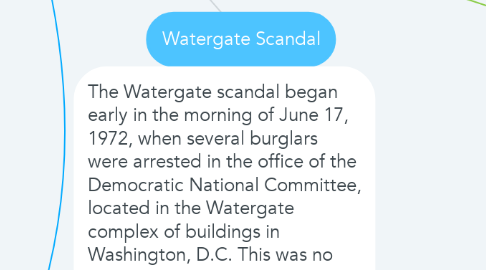
1. Serving as White House counsel from 1970 to 1973, Dean helped cover up the Nixon administration’s involvement in the Watergate break-in and illegal intelligence-gathering. But as the investigation was closing in, he had warned fellow staffers, “The jig is up. It’s over,” and reportedly said to Nixon, “We have a cancer within, close to, the presidency, that is growing.” Nixon fired him shortly thereafter.
2. Ehrlichman, Nixon’s advisor for domestic affairs, also served as head of the “Plumbers.” He attempted to cover up the botched Watergate break-in.
3. The Nixon administration White House chief of staff—known as the gatekeeper” to the Oval Office who once called himself "the president's son-of-a-bitch"—became a key figure in the Watergate probe as investigators zeroed in on tape-recorded conversations of White House meetings. One of the tapes included a now-famous 18-and-a-half-minute gap, which was later revealed to include a conversation between Haldeman and Nixon. Haldeman was also implicated in the so-called “smoking gun” tape, in which Nixon talked about using the CIA to divert the FBI’s investigation of Watergate.
4. Once described as “the most powerful man in the Cabinet,” the notoriously gruff and fiercely loyal Mitchell was Nixon’s attorney general before he resigned in 1972 to become director of the Committee to Re-elect the President. According to testimony in the Watergate hearings, Mitchell approved the break-in and bugging of the Democratic National Committee headquarters.
5. A White House communications adviser, Magruder played a key role in planning the Watergate break-in, and later covering it up.
6. Who Was Involved
6.1. THE BURGLARS
6.1.1. James McCord
6.1.1.1. A former CIA officer and FBI agent, McCord was one of the five burglars arrested at the Watergate complex, and the “chief wiretapper” of the operation. During the burglary, McCord, then security director of the Committee to Reelect the President (or CREEP), left a piece of tape on the latch of a stairwell door, inadvertently alerting a security guard to the burglary in progress.
6.2. Virgilio Gonzalez
6.3. A Cuban refugee and locksmith by trade, Gonzalez was one of the five burglars arrested at the Watergate complex on June 17, 1972. He had been recruited in Miami by E. Howard Hunt, who had played a key role in the CIA’s disastrous Bay of Pigs invasion.
7. THE WHITE HOUSE INSIDERS
7.1. John Ehrlichman
7.2. John Dean
7.3. H.R. Haldeman
7.4. John Mitchell
7.5. Jeb Stuart Magruder
7.6. Alexander Butterfield
8. The Watergate scandal began early in the morning of June 17, 1972, when several burglars were arrested in the office of the Democratic National Committee, located in the Watergate complex of buildings in Washington, D.C. This was no ordinary robbery: The prowlers were connected to President Richard Nixon’s reelection campaign, and they had been caught wiretapping phones and stealing documents.
9. As deputy White House chief of staff to President Nixon from 1969 to 1973, Butterfield controlled the secret taping system Nixon had installed in the Oval Office. He revealed the existence of the tapes when he was questioned by the Senate Watergate Committee, effectively sealing Nixon’s fate.
10. A former military prosecutor, Segretti was an operative for the Committee to Re-elect the President, known as the architect behind Nixon’s campaign of political sabotage against Democratic opponents. In one such smear campaign, he created an anonymous letter falsely claiming that former senator Henry M. "Scoop" Jackson had fathered an illegitimate child with a teenager.
11. As special advisor to the president, Colson was the mastermind behind many of the “dirty tricks” and political maneuvers—including spying on political opponents—that brought down the Nixon administration. As Colson told E. Howard Hunt in a recorded telephone conversation, he would write in his memoirs that “Watergate was brilliantly conceived as an escapade that would divert the Democrats’ attention from the real issues, and therefore permit us to win a landslide that we probably wouldn’t have won otherwise.”
12. Liddy, a former FBI agent who served as general counsel for the Committee to Re-elect the President—a campaign that eventually led to the unraveling of the Nixon administration—was responsible for planning and supervising the Watergate break-in. According to testimony heard in the trial, he received about $332,000 in campaign funds, which he used to carry out a number of intelligence-gathering operations.
13. THE ORGANIZERS
13.1. E. Howard Hunt
13.1.1. A former CIA operative, Hunt was a member of the so-called “Plumbers,” an informal White House team tasked with preventing and repairing information “leaks” such as the 1971 release of the top-secret Pentagon Papers. After investigators found his phone number in address books belonging to the Watergate burglars, they connected the dots between the burglary, President Nixon and his re-election campaign.
